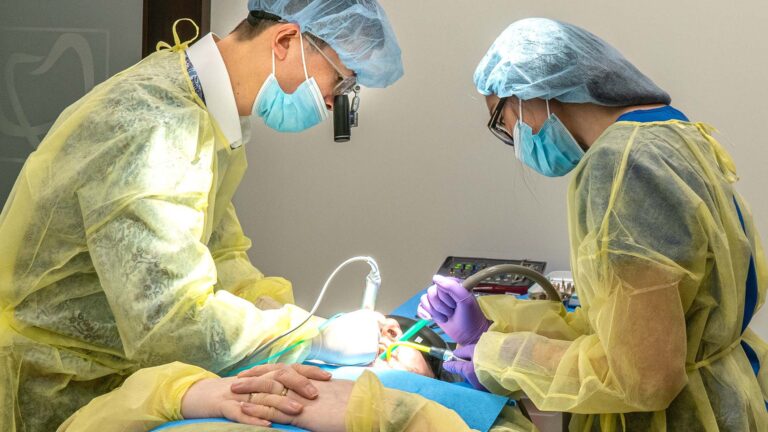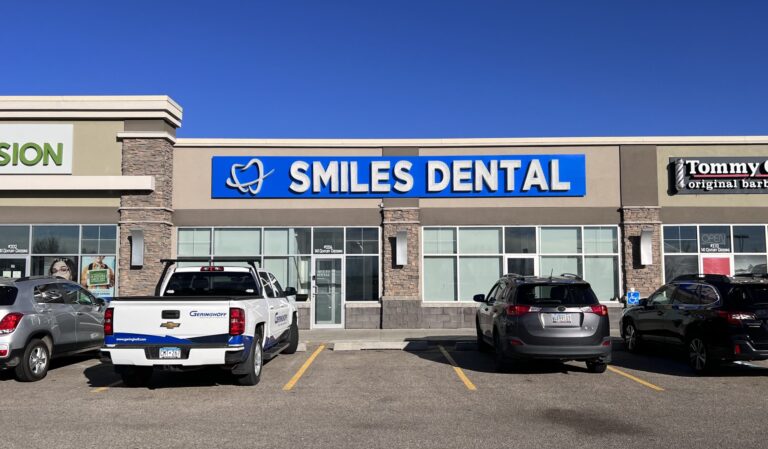Smiles Dental Group has a dentist for you, no matter where you are!
With seven dental clinics across Edmonton and surrounding areas, we’re the most accessible dental professionals in Edmonton. Our dental offices offer quality dental care from adult check-ups to emergency care and everything in between to ensure optimal oral health.
At Smiles Dental Group, healthy smiles and accessibility are our specialties. We offer evening and weekend hours and our emergency location is open 365 days a year. No matter what dental emergency arises, we’re confident you’ll leave our office with full smiles.

At Smiles Dental Group, we believe that maintaining a healthy smile shouldn’t come at an excessively high cost. Unique among dental clinics in Alberta, we set all of our fees below the Alberta Dental Association (ADA) fee guide. This commitment places us among the top 3% of affordable dental practices in the region.
We are dedicated to making our patients comfortable not only with our exceptional care but also with our transparent and affordable pricing. It’s important to us that you understand we are charging less for the same quality services offered by virtually all other dental clinics.
We’re here to help you maintain a healthy smile without breaking your budget.

Visit us at any of our 7 locations! Currently accepting new patients, the dental clinics located in and around Edmonton are designed to be as convenient as possible. We offer general, cosmetic, emergency, and family dentistry services at every dental clinic.
Our Brintnell dental clinic provides North Edmonton with quality dental services they can count on.
Our Secord dental clinic is our newest dental clinic, located in West Edmonton. New patients & walk-ins welcome!
Our South Edmonton dental & emergency clinic is our biggest dental clinic in Edmonton, open 365 days/year!
Our dental clinic in Mill Woods is an established practice that provides family-oriented dental services.
Our St. Albert Dentists are proud to serve the St. Albert community at our modern dental clinic.
Our Spruce Grove location is a well-established dental clinic offering same-day emergency dental care.
As one of the largest, solely, and locally owned Edmonton Dental-based practices we strive to build trusting relationships with all of our valued patients. All 7 of our premium dental clinics across Edmonton, Spruce Grove, St. Albert, and Sherwood Park offer convenient, affordable, quality modern dentistry to all of our patients.

At Smiles Dental Group, we’re passionate about enhancing your smile, one quality treatment at a time.
As a premium family dentist in Edmonton, we’re dedicated to providing top-tier dentistry and superior patient care in a comfortable environment. Our dedicated and compassionate team, equipped with state-of-the-art technologies such as digital X-rays, cone-beam computerized tomography, and intraoral scanning, strives to ensure the best possible dental experience for you and your family.

We simplify the process so that caring for your beautiful smile doesn’t weigh heavy on your wallet.
While most Alberta dentists set their charges at or above the provincial dental fee guide, Smiles Dental Group takes a different approach. We keep our fees below the Alberta Dental Fee Guide to make quality dental care more accessible. We also offer easy financing options and direct billing to minimize out-of-pocket expenses. We provide direct insurance billing to most insurance and government plans.

At our dental clinics, we prioritize your time and make scheduling appointments as seamless as possible.
Finding a new dentist that is close to home and suits your schedule can be a challenge, but not at Smiles Dental Group. Our accommodating dentists are available evenings and weekends, across 7 convenient locations, eliminating the need to disrupt your schedule. Plus, with one of our clinics open 365 days/year, we ensure dental appointments fit your calendar, not the other way around.
At Smiles Dental Group, our dental professionals offer a variety of dental treatments to cater to your diverse oral health care needs. Whether you’re seeking to enhance your smile’s aesthetics or need more advanced restorative dentistry, we’re here to help. All dental services are provided by General Dentists.
As a one-stop dental solution, we are equipped to handle all your dental needs under one roof. Whether you’re considering cosmetic changes or need a complex restorative procedure, our team of experts is ready to guide you through the process and deliver the results you deserve.
From routine cleanings to wisdom teeth extractions, our dentists provide a broad array of quality dental services. We offer white fillings, crowns, bridges, dentures, root canals, and more – all to keep your family’s smiles healthy and radiant.
Your smile is one of your most noticeable features. Discover how to amplify its appeal with services like Invisalign, veneers, teeth whitening, and porcelain crowns. Enhance your smile’s brilliance with Smiles Dental Group’s cosmetic solutions.
One of the best ways to replace missing teeth is with dental implants. Whether you need one or many implants, we offer both surgical and prosthetic options. Regain a complete, confident smile with our implant dentistry services.
Smiles Dental Group is at your service 7 days a week, 365 days a year, including evenings, weekends, and holidays. Whether it’s a root canal treatment, extraction, or tooth repair, we’re here to assist promptly and effectively.
At Smiles Dental Group, we understand that dental emergencies can be painful, unexpected, and require immediate attention. That’s why our Edmonton emergency dental office operates 7 days a week, 365 days a year – including evenings, weekends, and holidays. From toothaches and root canal treatments to tooth extractions and damaged teeth repair, we’re here to help when you need us the most.
Remember, untreated dental emergencies can significantly impact your overall dental health. Don’t let missing teeth or intense pain ruin your smile or your day. We offer same-day emergency appointments because we care deeply about your dental health and comfort.
For more information, visit our emergency dental care page.

Our dental clinics in Edmonton and nearby areas are all set to welcome new patients!
Our dentists are fully licensed by the Alberta Dental Association and hold degrees from accredited dental faculties in Canada, the U.S., and Australia. From routine check-ups to emergency procedures, our highly trained dental team ensures comprehensive care. Don’t hesitate to book your appointment today, or feel free to walk in.
At our clinics, we are always prepared to offer you exceptional dental care.

At Smiles Dental Group, we take pride in offering top-quality, affordable, and convenient dental services that cater to your entire family’s dental needs. Our commitment to surpassing industry standards and ensuring patient comfort is what sets us apart. With us, you’re not just getting dental treatment – you’re joining a community that genuinely cares about your oral health.
Don’t delay your journey toward a brighter, healthier smile. Request an appointment online and start your journey with us today. Your smile is our success.

Our Edmonton dentists offer a wide range of dental services such as cleanings, clear aligners, dental surgeries, wisdom teeth extractions, dental implants. We even offer elective esthetic dental procedures like porcelain veneers, tooth-coloured (mercury-free) fillings, in-office teeth whitening, as well as many others.
Did you find everything you need? Our team is always happy to serve your dental needs. We have 7 different dental clinics in and around Edmonton. We offer Emergency Dental Services 7 days/wk, 365 days/yr.
If you’re wondering where our locations are, please see them all here.